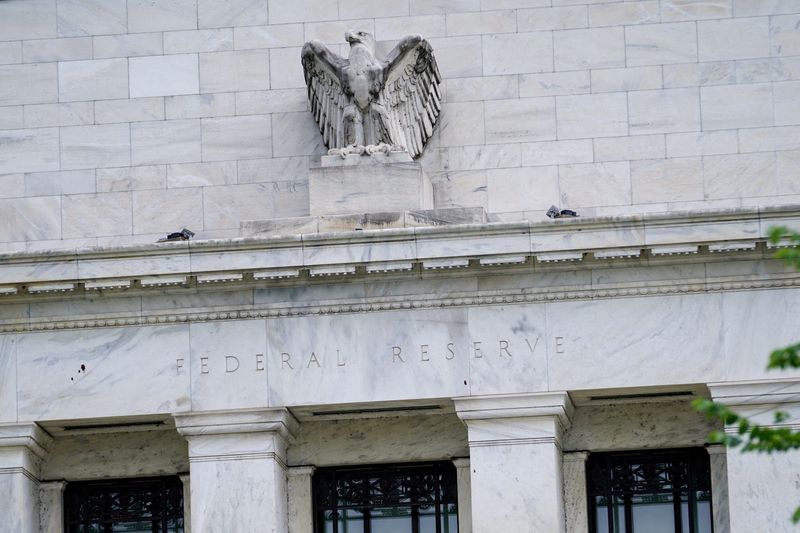Investing.com’s stocks of the week
By Gertrude Chavez-Dreyfuss
NEW YORK (Reuters) -Bond investors are selectively adding longer-dated maturities to their portfolios on bets the Federal Reserve will delay cutting interest rates and reduce them at a slower pace than in previous easing cycles, starting with a decision to stand pat on rates at this week's policy meeting.
Some portfolio managers taking this view are particularly focusing on intermediate Treasury maturities, such as five-year notes for juicier returns. Longer-duration Treasuries tend to outperform shorter-dated ones in a rate-cutting cycle as U.S. yields fall.
With U.S. inflation stubbornly persistent and the labor market still robust, the Fed is widely expected to hold interest rates steady in the 5.25%-5.50% range at the end of its two-day meeting on Wednesday. Fed Chair Jerome Powell is likely to sound cautiously hawkish on the economic outlook, reinforcing expectations that the first rate cut will be delayed to either September or December.
For 2024, U.S. rate futures traders are pricing just one 25 basis point rate cut, more likely in December .
"We have been in the shallow easing cycle camp for some time. There are structural factors in the economy that's going to keep inflation above the 2% target more often," said Matt Eagan, portfolio manager and co-head of the Full Discretion Team, at Loomis, Sayles & Company in Boston.
He said investors need to be compensated for inflation seen averaging between 2%-2.5% and an inflation-adjusted rate that is roughly 2% on the long end.
Marcelo Carvalho, global head of economics at BNP Paribas (OTC:BNPQY) in London said inflation globally has become more ingrained due to higher public sector investment spending.
"Inflation we think probably settles down on average at higher levels in the coming years than before...where we got used to long periods of low inflation and low rates," Carvalho said.
GO FOR THE BELLY
The best way to play this scenario is to focus on buying the "belly" of the curve, such as five-year notes, which could provide the best bang for your buck, Loomis Sayles' Eagan said.
This bet is predicated on the fact that with inflation staying above 2%, the Fed's neutral rate, a level at which policy rates are considered not too easy or too tight, will also be higher.
The Fed's neutral rate is currently at 2.6%. But bond investors such as Loomis Sayles have penciled in a neutral rate of anywhere between 3.5% to 4% which means the Fed won't be cutting as much.
With a higher neutral rate, there's a floor under Treasury yields, analysts say, particularly for 10-year notes, which are typically bought by investors when the Fed starts cutting rates.
With the 10-year yield's fair value seen at 4.5%, and currently trading at 4.66%, market participants said there's not much scope for the 10-year yield to fall and therefore returns could be limited.
"Once the Fed starts to cut rates, all that rate decline is going to happen on the front end of the curve and the long-end will have much less scope to come down," Eagan said.
In previous U.S. rate-cutting cycles in which the economy saw structurally declining growth and inflation, the policy rate would often fall by several percentage points, analysts said. Once the Fed began to ease, it tended to slash rates aggressively, and investors bought longer-dated Treasuries - the 10s and 30s - to take advantage of the more attractive returns as their yields sank.
Clayton Triick, head of portfolio management, Public Strategies, at Angel Oak Capital Advisors in Atlanta, said going back down to a 1.5% to 2.5% fed funds rate would not be reasonable anymore, citing the undeniable backdrop of higher inflation. He sees a neutral rate of between 3.5% and 4.5%.
In such an environment, he said there is value in owning, not the long, long end like the 10s and 30s, but fixed-income assets with two- to five-year maturities, echoing Loomis Sayles' strategy.
"It's very difficult for us to really predict where the long end will go especially given the path of fiscal policy in the United States," said Triick.
"We do not see big changes happening on the fiscal front and so that could mean higher risk premiums, higher term premiums in the yield curve."
